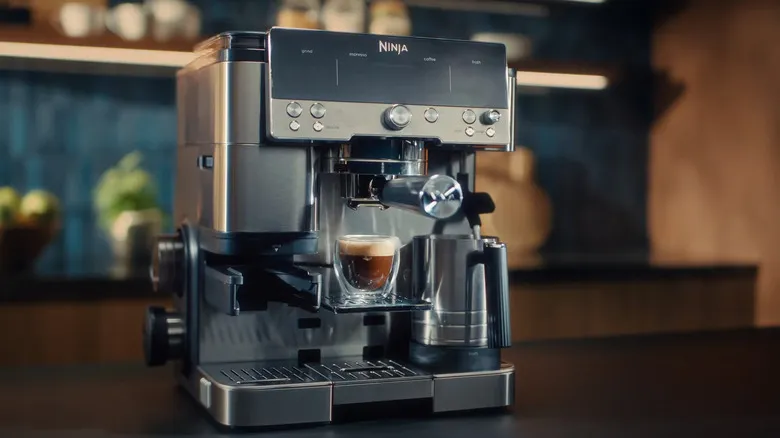A closer look at the Ninja Luxe Café
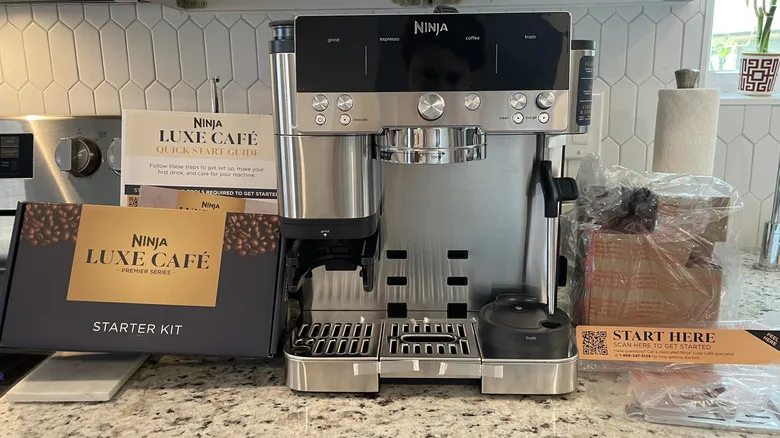
The Ninja Luxe Café boasts three standout features. First, it includes a grinder equipped with the innovative Barista Assist Technology. This unique system merges a grinder with a precise scale, allowing for the accurate measurement of coffee grounds for espresso, drip coffee, and more. This feature is particularly beneficial, as transitioning between espresso and ground coffee can often be a challenge for home brewers. Users simply load whole beans into a hopper, select their desired grind size, and the machine grinds the exact amount directly into the portafilter.
The second feature focuses on the brewing capabilities of the machine. With a simple dial, users can choose to brew anything from a double shot of espresso to a 16-ounce cold brew. While the options for drip coffee and espresso are standard, the inclusion of cold brew and cold-pressed espresso options adds an exciting twist (perfect for crafting an espresso martini).
Lastly, the machine is equipped with an advanced milk frother that accommodates both dairy and non-dairy creamers, capable of producing steamed, frothed, and cold-foamed milk. This thoughtful addition caters to the growing number of coffee enthusiasts who prefer alternative dairy options.
Assembling the Ninja Luxe Café
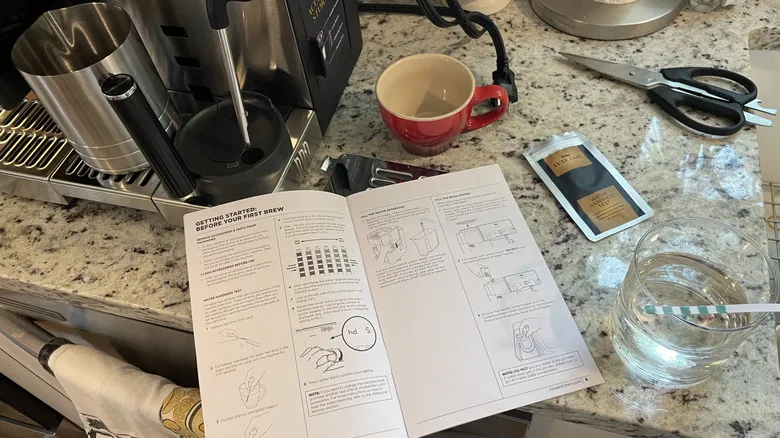
Unboxing the Ninja Luxe Café was perhaps the most challenging aspect of this review. There were numerous gadgets and pieces of equipment to unwrap, including a portafilter, double basket, luxe basket, funnel, tamper, milk jug, and cleaning brush, along with several informative booklets—a recipe guide, a quick start guide, and an official owner's manual. While it may seem like a lot of reading, I found each guide to be quite straightforward.
The machine comes fully assembled right out of the box. The first step in maintenance is to ensure your water and coffee beans are properly set up. Start by testing the hardness of your tap water, as it significantly influences the flavor and texture of your espresso. Ninja provides a convenient test strip for this purpose. I discovered that my water was very soft, so I adjusted the dial to zero.
Next, I filled the hopper, the funnel container located above the grinder, with whole coffee beans. Immediately afterward, I needed to flush the machine by brewing a plain hot cup of water (approximately 12 ounces) with an empty portafilter attached, as it won’t operate otherwise. Once that was done, the Ninja Luxe Café was ready for brewing!
The drip coffee test
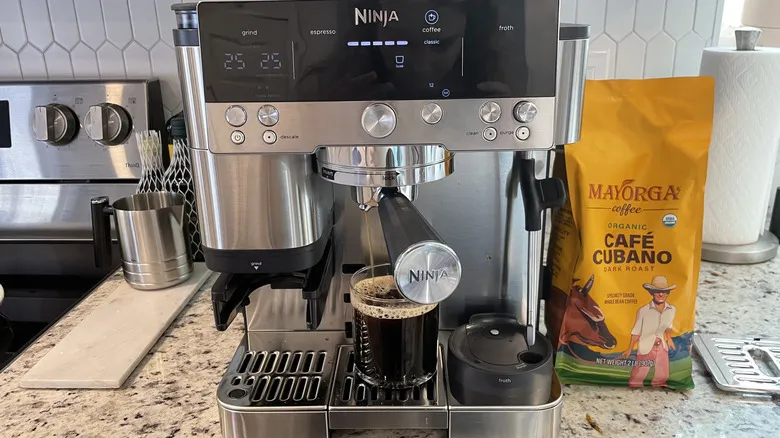
To keep things straightforward, I opted to make a basic cup of coffee. The first step is to prepare the portafilter, which is a handle-equipped container that holds the coffee grounds for brewing. For drip coffee, you need to use the largest basket, known as the luxe, as it accommodates more grounds than the double basket.
After selecting "classic" and a 12-ounce size using the center dial, I placed the funnel over the portafilter and secured it in the grinding cradle. For drip coffee, the machine recommends setting the grinder to 25, which produces a relatively coarse grind. Once everything was aligned, I pressed the grind button, and the Barista Assist Technology took over. I then locked the portafilter into the main hub and hit the brew button. For the temperature, I chose medium, as the manual indicated that dark roasts (which I was using) require a low (1) to medium (2) temperature, while light roasts can go up to high (3).
Surprisingly, I managed to get everything right on my first attempt—I'm just as astonished as you are—so I must commend the clear instructions. In terms of flavor, the coffee was incredibly strong, one of the most intense brews I've had at home. It was a bit too robust for my liking, so for my second attempt, I made an 8-ounce cup and lowered the temperature to 1. Voilà, the perfect cup of coffee!
The espresso test
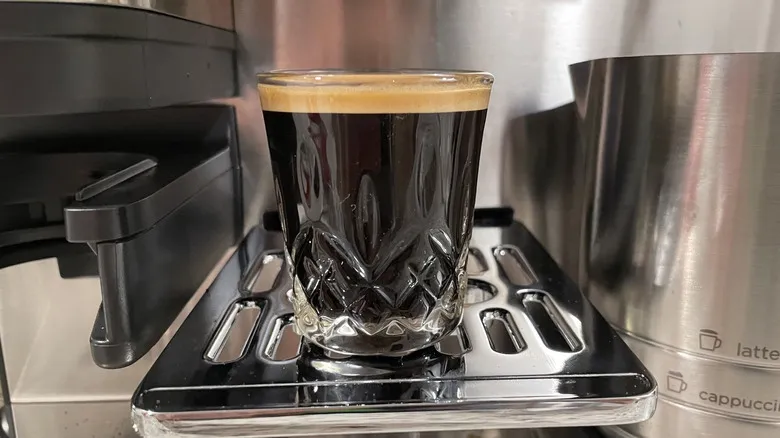
Espresso and coffee are fundamentally different, which is why many people choose to invest in a high-end espresso machine. With that in mind, I regarded this part of the testing as the most crucial, as the Ninja Luxe Café aims to deliver exceptional espresso at home.
The process for making espresso was quite similar to brewing drip coffee, with a few adjustments to the settings. First, I replaced the standard basket with the double basket designed for espresso grounds in the portafilter and selected the "espresso" option on the main dial. Almost immediately, my grinder prompted me to change the grind setting from 25 to 12 (extra fine), since espresso requires a much finer grind. Once the grinding was complete (indicated by a beep), I was instructed to tamp down the grounds to prevent overflow. The brewing process was quick, and I enjoyed watching a pleasing layer of crema develop on top — this delicate foam created during brewing is often seen as a hallmark of a quality espresso.
Once again, I achieved great results on my first attempt. The crema enhances the espresso's flavor, allowing it to linger on the palate, reminiscent of a much pricier setup than a typical home brew. As this was espresso, it had a bold, intense flavor that I could easily soften with a touch of sugar or savor on its own.
The cold brew test

Now, let’s talk about the cold brew feature, which I was eager to test out. It promised to create a robust concentrate that I could add ice to without worrying about it tasting like diluted coffee as the ice melted. This is the key distinction between cold brews and iced coffees: the intensity of flavor. The Ninja Luxe Café also offers an "over ice" coffee option, which produces regular chilled coffee. While that option works well, the cold brew function easily outshines it.
If you switch directly from a hot beverage to a cold one, the machine prompts you for a "rinse," which is essentially a quick flush of hot water. After that, you simply follow the same process as you would for making drip coffee, adjusting the grind and basket size as necessary. In just under five minutes, my dark roast (the ideal choice for cold brew) was ready.
I didn’t get it right on my first attempt, but I attribute that to my own misunderstanding rather than any flaws in the instructions. Initially, when I made cold brew, I forgot to add ice to my cup, leading me to believe I was getting significantly less than eight ounces of coffee. Once I realized my mistake (it actually makes eight ounces of coffee WITH ice), I was able to fully appreciate this feature. Sweetened with cold foam, it was as good as any cold brew I’ve had, and I believe it can compete with any chain version out there.
The cold-pressed espresso test
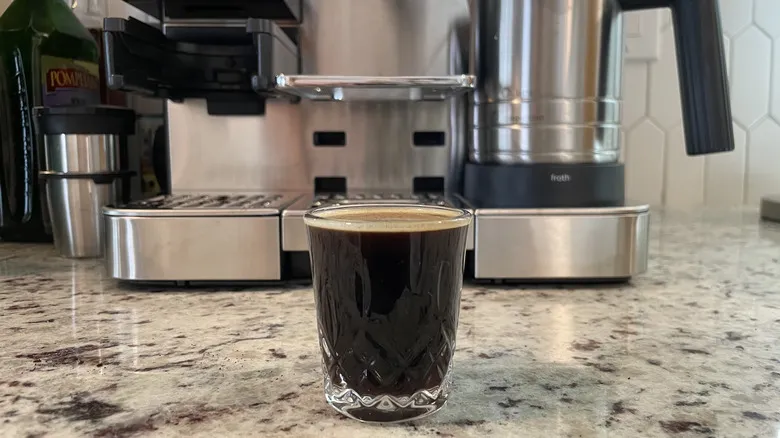
Another groundbreaking feature of this machine is its cold-pressed espresso capability. Cold-pressed espresso is created using cold water and high pressure, and it has various applications, with the espresso martini being the most popular. (You can also use cold brew to whip up espresso martinis.) Additionally, there are many recipes that can benefit from cold-pressed espresso, and the Ninja Luxe Café inspiration booklet offers several delightful ideas, such as iced dirty chai and iced hazelnut lattes.
For cold-pressed espresso, I found that a slightly coarser grind (17) worked better than the finer grind used for hot espresso. Other than that, I followed the same procedure as I would for regular espresso, and it was just as straightforward. The drip process was a bit slower, but not significantly so.
During the tasting, I could barely distinguish between this shot and the hot version, aside from the temperature difference. Speaking of temperature, I noticed that my cold-pressed espresso had less crema compared to the hot version, but this didn’t impact the flavor for me. If you’re planning to make espresso martinis, a quick shake in a shaker will help restore that foam. I’m looking forward to using this as a shortcut for crafting iced caffeinated beverages, especially the milk-rich iced lattes.
The hot chocolate test
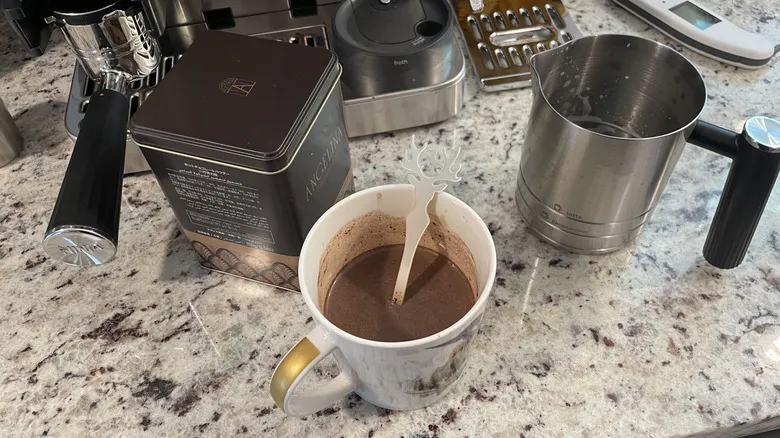
One of the few drawbacks I've observed with this machine is its lack of a dedicated hot water function, which would be beneficial for users looking to prepare teas, flat whites, and hot chocolates. This seems like an oversight, especially since the machine boasts nearly every other feature. However, the milk frother can still satisfy those in the mood for a gourmet hot chocolate.
The lowest setting on the milk frother wand is the "steam" option, which heats milk, cream, or other dairy to the perfect temperature (i.e., until it starts steaming). For this test, I used the steamer to create a milk-based hot chocolate. I poured eight ounces of milk into the designated jug and positioned it under the wand. In just over three minutes, I had steaming milk ready for the addition of hot chocolate mix.
The outcome had just enough heat to melt the chocolate pieces in my premium French cocoa mix, but it wasn't as smooth as it could have been, and it ended up lukewarm. While commercial powder mixes dissolve adequately, traditional hot cocoa lovers might find the milk's temperature disappointing. Of course, if you're considering the Ninja Luxe Café primarily for hot chocolate, you might be overlooking its other features.
Milk frother and steamer test
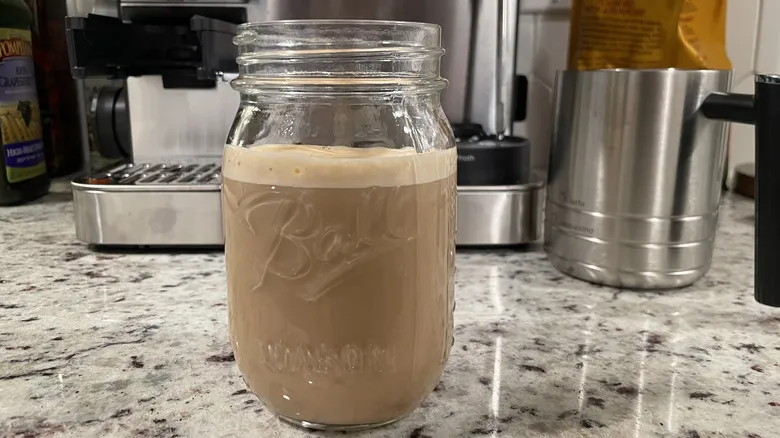
After a quick diversion into the world of hot chocolate, I turned my attention to the steamer/frother for its true purpose: crafting delightful lattes, cappuccinos, and cold cream-topped iced beverages. With this handy feature, I could potentially master the art of latte design. For seasoned baristas, there's a manual frothing mode available to refine their skills. However, as a novice, I opted to experiment with the preset options.
Using whole milk, I achieved excellent results with the steam, thin froth, and thick froth settings. Each one delivered on its promise, allowing me to create semi-professional versions of some trendy drink orders. For the cold foam, I found that using a creamier dairy option, such as half-and-half or sweetened creamer, yielded the best results. It was a thrilling enhancement to my cold brew. Remember, the creamier the dairy, the thicker the final product. Whole milk produced richer outcomes than skim milk, and heavy cream was even more indulgent.
After finishing your foam, it's essential to promptly wipe down the wand and return it to its position for an automatic "purge," which releases any leftover hot water into a drain hole at the base of the machine. If you forget to do this before your next foam session, you might inadvertently spray that water into your waiting jug of milk.
Plant-based milk frother and steamer test

As dairy alternatives remain a popular choice in commercial cafés, Ninja has developed a steaming wand that can seamlessly switch between real dairy and plant-based milks. To evaluate this feature, I tested two different oat milks: Califia Farms Extra Creamy Oat Milk and Kirkland Signature Oat Milk from Costco. I found that Kirkland's oat milk was slightly thinner than the Califia brand, providing a comparison between oat whole milk and oat creamer.
For a straightforward steam and light foam, the Kirkland oat milk produced a satisfactory latte or creamy coffee, though the foam was not nearly as airy as that made with real dairy. If you're aiming for a cold foam or a thick, cappuccino-style foam, you'll want to opt for a creamier plant-based option like Califia Farms. However, even that won't quite match the richness of a traditional heavy cream-based cold foam.
Nonetheless, if you're dedicated to a plant-based milk lifestyle, the Ninja Luxe Café ensures you can still craft high-quality lattes and other frothy beverages. Just remember to purge and clean your wand between uses, but after that, it's quite easy to operate.
Cleaning your Ninja Luxe Café

I would suggest that this machine requires a weekly low-maintenance cleaning, which involves emptying the water from the base, wiping down the espresso-splattered stainless steel surfaces, and scrubbing the central drip tray. If you're as clumsy as I am, the tray beneath the coffee grinder will likely need a good brushing too, as those annoying spilled coffee grounds tend to accumulate in the nooks and crannies.
A convenient feature of the Ninja is a small cylinder located in the left corner that rises as the water fills the base, serving as a reminder to empty it. Additionally, there’s a spout in the back left corner labeled "pour," which allows you to dispose of the water without having to disassemble the base. These thoughtful design elements make the overall cleaning process much less intimidating.
Regarding more extensive cleaning, such as descaling and a thorough cleaning cycle, the Ninja team has provided the necessary tools and instructions. Since I’ve only used my machine for about two weeks, I haven’t received a notification to descale it (a 90-minute process using vinegar or descaling powder), nor have I noticed any decline in quality that would necessitate a cleaning cycle (a six-minute process with a cleaning tablet and rubber disc, both included in the initial kit). I also have a handy brush for cleaning the grinder when switching from light roast to dark roast.
General maintenance and care

While the primary focus of maintaining the Ninja Luxe Café will be on thorough cleaning, there are a few additional aspects highlighted in the manual that warrant your attention. One component that may require replacement over time is the rubber gasket, which serves as a reliable barrier to prevent leaks from the portafilter during brewing. If you notice excessive dripping, it’s advisable to order a new gasket and replace it using a screwdriver.
A brief note on customer service: this is actually the second Ninja Luxe Café machine I’ve received, as the first one had issues with the Barista Assist Technology. It either ground too many coffee beans or not enough, and it frequently prompted me to refill the hopper. When I contacted the Ninja team, they promptly assisted me in returning it, arranged for a pick-up at my home, and sent me a replacement at my convenience. I truly appreciated this level of customer service, especially for a machine priced higher than a standard Keurig.
If you encounter any problems with your machine (which are infrequent based on other reviews I've seen), don’t hesitate to reach out to Ninja for assistance. They appear to be eager and prepared to ensure their customers are satisfied with their purchases.
My conclusions
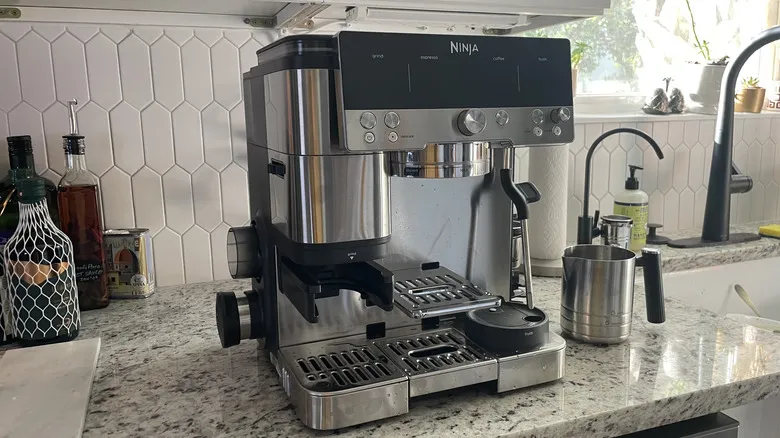
Reflecting on the initial questions I raised at the start of this review, I find myself with numerous positive responses. This machine produces an espresso that is as straightforward and effortless as any I've encountered at home, and it also brews an excellent cup of coffee. With the added benefits of cold brew and steaming capabilities, I believe this espresso maker justifies its nearly $500 price point — in fact, it feels like a bargain.
However, this machine is not designed for the casual or indifferent coffee drinker. If coffee is merely a way for you to wake up, you may not find this to be a worthwhile investment. It is a sizable machine that demands regular upkeep and more initial setup than a standard Keurig. But the flavor difference is undeniable, and if that matters to you, I recommend getting the machine.
On the downside, I do find the absence of a hot water option to be somewhat frustrating. While this machine isn't intended for tea or hot chocolate, having that feature could have been a nice addition. It’s also not particularly useful for making a rich hot chocolate, but that’s a minor complaint.
In summary, I’m pleased to incorporate this machine and its outstanding brews into my morning routine.
My methodology
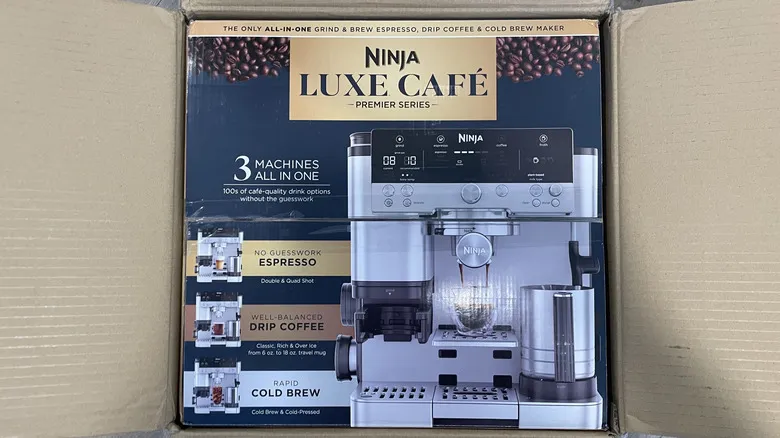
Ninja provided a machine for evaluation and sent a replacement when I encountered problems with the Barista Assist Technology. For my coffee and espresso base, I utilized Mayorga Organics Coffee Cubano Roast Beans, which are a dark roast. In the regular dairy test, I opted for Publix Whole Milk and International Delight Sweet & Creamy Coffee Creamer. For the plant-based dairy steaming and frothing tests, I used Califia Farms Extra Creamy Oat Milk and Kirkland Signature Oat Milk from Costco.
During the tasting, I sampled the coffee and espresso both plain and with cream, as well as with cream and sugar. The water I used is filtered through a Rainsoft system, so it is considered filtered water.
Recommended
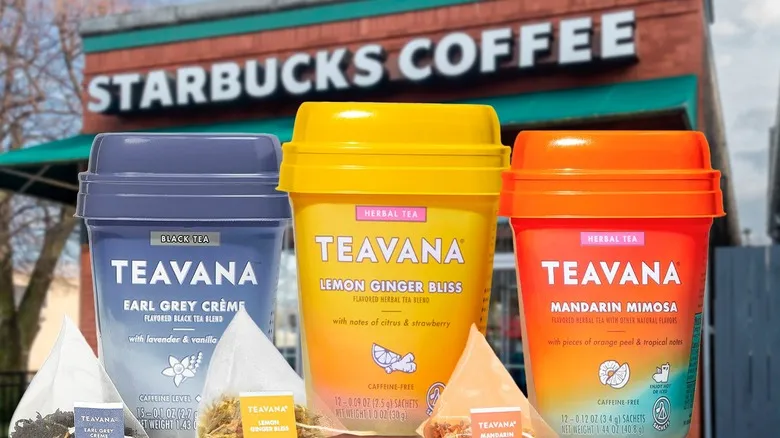
The Rise And Fall Of Teavana
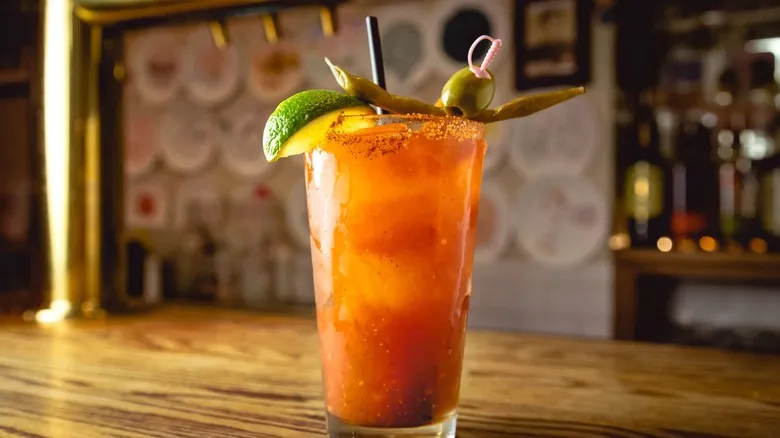
Red Snapper Vs Bloody Mary: What's The Difference Between The Cocktails?
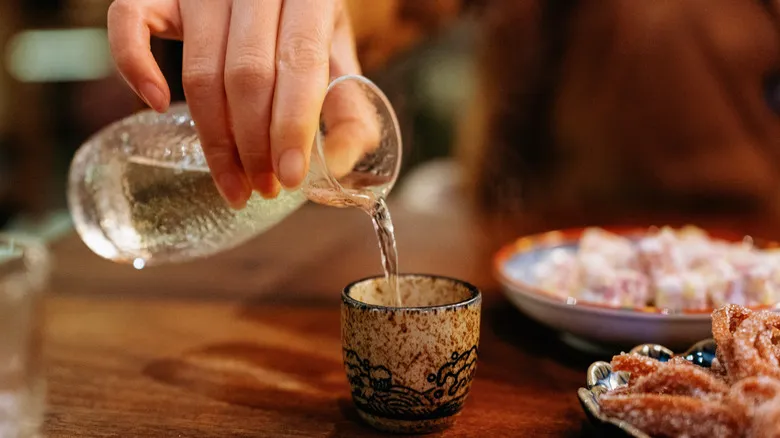
What To Know Before Ordering Sake In Japan
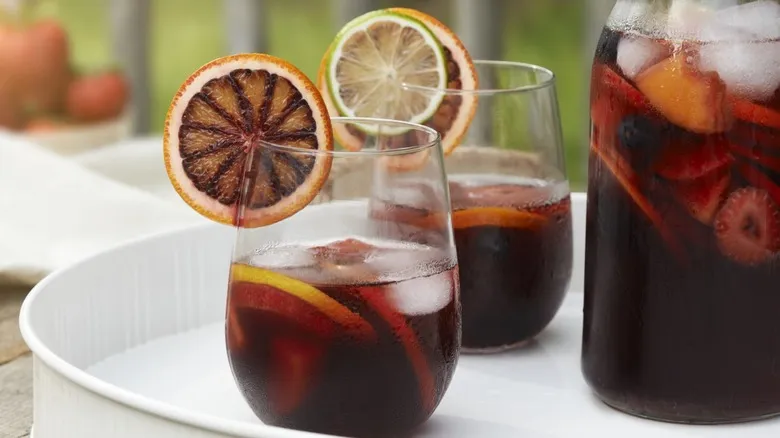
Sangria Vs Mulled Wine: Is There A Difference?
Next up

